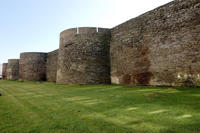You are in: Europe -> Spain -> Roman Walls of Lugo, and traditional search or Image Gallery will yield results of this site only
Roman Walls of Lugo
| Site number: | 987 |
|
| Type of site: | Cultural | |
| Date: | 3rd century | |
| Date of Inscription: | 2000 | |
| Location: | Europe, Spain, Province of Lugo, Autonomous Community of Galicia | |
Up to 75 images are shown here. Click on each for more details or on Image Gallery for more images.
| Description: | The walls of Lugo were erected in the late 3rd century to provide protection for the Roman town of Lucus. The entire circuit has survived undamaged to this day and now stands as the finest example in Western Europe showcasing late Roman fortifications. --WHMNet paraphrase from the description at WHC Site, where additional information is available. | |
| Lugo is a city in northwestern Spain, in the autonomous community of Galicia. The city was probably founded by Celts of the Cult of Lugh, The bearer of the Grial,and "The God of Light", many hundreds of years B.C. and later conquered by Paulus Fabius Maximus and called Lucus Augusti in 13 BC on the positioning of a Roman military camp, while the Roman Empire completed the conquest, in the North, of the Iberian Peninsula. Situated in what was the Roman province of Hispania Tarraconensis, it was the chief town of the tribe of the Capori. Though small it was the most important Roman town in what became Gallaecia during the Roman period, the seat of a conventus, one of three in Gallaecia, and later became one of the two capitals of Gallaecia, and gave its name to the Callaïci Lucenses. The Conventus Lucensis, according to Pliny, began at the river Navilubio, and contained 16 peoples, besides the Celtici and Lebuni; and though these tribes were not powerful, and their names "barbarous" to Roman ears, there were among them 166,000 freemen. Lucus was the seat of a bishopric by the later 5th century at the latest and remained an administrative center under the Suebi and Visigoths, before going into such a decline that the site was found to be deserted in the middle of the eighth century by bishop Odoario, who set about reviving it. Tenth century attempts at rebuilding its casas destructas (abandoned tenements) suggest that it remained a town only on paper: the seat of a bishopric, administered by a count, from which royal charters were issued. "Its commercial and industrial role was insignificant", Richard Fletcher wrote of 11th century Lugo. During the High Middle Ages the city recovered. The Romans had inhabited Lugo in 13 B.C., The Romans introduced some culture to them, and also Built a large wall, protecting the city (built for the Romans not Spain), And inside was a beautiful cathedral which still stands. Located on a site above the Minho river and named after the Celtic god Lugus, it is the only city in Europe to be surrounded by completely intact Roman walls, which reach a height of 10 to 15 metres along a 2'5 km circuit ringed with 71 towers. The walk along the top is continuous round the circuit. These 3rd century walls are protected by UNESCO as a World Heritage Site. The bridge over the Minho is essentially of Roman date, though many repairs over the centuries have effaced its Roman character. --Wikipedia. Text is available under the Creative Commons Attribution-ShareAlike License. | ||
| Source: | http://whc.unesco.org/en/list/987 | |
| Reference: | 1. UNESCO World Heritage Center, Site Page. | |

















